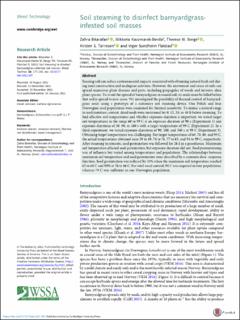| dc.description.abstract | Reusing soil can reduce environmental impacts associated with obtaining natural fresh soil during road construction and analogous activities. However, the movement and reuse of soils can spread numerous plant diseases and pests, including propagules of weeds and invasive alien plant species. To avoid the spread of barnyardgrass in reused soil, its seeds must be killed before that soil is spread to new areas. We investigated the possibility of thermal control of barnyardgrass seeds using a prototype of a stationary soil steaming device. One Polish and four Norwegian seed populations were examined for thermal sensitivity. To mimic a natural range in seed moisture content, dried seeds were moistened for 0, 12, 24, or 48 h before steaming. To find effective soil temperatures and whether exposure duration is important, we tested target soil temperatures in the range 60 to 99 C at an exposure duration of 90 s (Experiment 1) and exposure durations of 30, 90, or 180 s with a target temperature of 99 C (Experiment 2). In a third experiment, we tested exposure durations of 90, 180, and 540 s at 99 C (Experiment 3). Obtaining target temperatures was challenging. For target temperatures of 60, 70, 80, and 99 C, the actual temperatures obtained were 59 to 69, 74 to 76, 77 to 83, and 94 to 99 C, respectively. After steaming treatments, seed germination was followed for 28 d in a greenhouse. Maximum soil temperature affected seed germination, but exposure duration did not. Seed premoistening was of influence but varied among temperatures and populations. The relationships between maximum soil temperature and seed germination were described by a common dose–response function. Seed germination was reduced by 50% when the maximum soil temperature reached 62 to 68 C and 90% at 76 to 86 C. For total weed control, 94 C was required in four populations, whereas 79 C was sufficient in one Norwegian population. | en_US |

